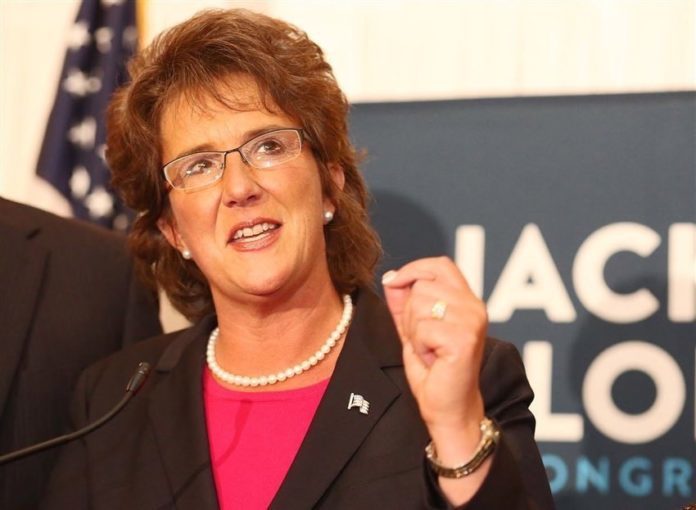Democrats running for Congress in Indiana are showing reinvigorated signs of life after years of brutal defeats, raising liberal hopes that a “blue wave” could reach the state and help them retake two districts where they’ve lost control in recent years.
The districts, one anchored around the northern rust belt city of South Bend, the other stretching from the Indianapolis suburbs south to the Ohio River, used to elect conservative Democrats. But ever since the tea party’s 2010 uprising secured Republican dominance in the state and granted the GOP control of the once-in-a-decade redrawing of legislative and congressional districts, Democrats have floundered.
Now, feeding off popular sentiment against President Donald Trump, both districts have drawn spirited campaigns that are shaping up as a proxy war between the liberal Bernie Sanders’ wing of the party and more centrist business Democrats ahead of the May 8 primary.
The ultimate goal is taking down incumbents Jackie Walorski, a three-term congresswoman in northern Indiana’s 2nd District, and Joseph “Trey” Hollingsworth III, a Tennessee native who moved to southern Indiana’s 9th District in 2015, shortly before launching his first campaign.
What remains to be seen is whether Indiana Democrats will enjoy the same flurry of enthusiasm that helped propel others to improbable victories, like western Pennsylvania’s Conor Lamb, who won a reliably Republican seat in March during a closely watched special election.
“I have been busier with this primary than I was in 2016 when the Bernie and Hillary (Clinton) thing was going on,” said Jason Critchlow, chairman of the St. Joseph County Democratic Party, which encompasses South Bend. “Gerrymandering has made it difficult, no doubt. But if any year is the one to do it, it’s this year. And if we don’t execute this year, I don’t know what happens.”
Democrats think both GOP incumbents are vulnerable.
They charge that Walorski has been absent from the district and does not meet with constituents outside tightly controlled meetings. They deride Hollingsworth as a carpetbagger who is clueless about southern Indiana. Hollingsworth, the scion of a Tennessee business mogul, cleared a crowded GOP primary field in 2016 thanks to attack ads run by a Super PAC financed by his wealthy father, which garnered him the bipartisan nickname “Tennessee Trey.”
As of March 31, Walorski had an overwhelming campaign cash advantage over Democrats Mel Hall, Yatish Joshi and Pat Hackett.
Hall, a former health-care executive, has said that Lamb’s victory illustrates that the 2nd District “is now up for grabs.” But before Hall, a centrist who many view as the favorite in the race, can focus on a general election campaign he must beat Joshi and Hackett, who hail from the party’s left.
“I want to shake up the Democratic Party from top to down,” said Joshi, a businessman who is calling for an increased minimum wage and “Medicare for all.”
The district has historically elected conservative Democrats, like Sen. Joe Donnelly, who held the seat for three terms before it was redrawn by Republicans after the 2010 census. Donnelly is also on the ballot this year and is considered one of the most vulnerable Democratic senators in the country.
Further south, the main Democratic candidates hoping to unseat Hollingsworth in the 9th District have run unabashedly progressive campaigns. Both Dan Canon, a civil rights lawyer, and Liz Watson, a former congressional staffer who is endorsed by a Sanders-affiliated group, have called for higher wages, paid family leave and a single-payer health care system.
But in a district that has historically been more conservative, it’s far from certain voters will go along.
“I think there’s going to be a blue wave,” said Watson, who has sought to align herself politically with Sens. Elizabeth Warren and Bernie Sanders. “It’s time for a change.”
Hollingsworth hasn’t raised as much money as Watson over the past nine months. But the 34-year-old has a net worth that is greater than $50 million to tap into, according to a 2016 financial disclosure.
Mark Fraley, the Democrats’ deputy chairman for the 9th District, said the keys to succeeding — and overcoming Republican gerrymandering — are a depressed GOP turnout, combined with an energized Democratic base running up the numbers in Bloomington and Indiana’s Louisville suburbs. He said high turnout from Latinos and students in Bloomington, home to Indiana University, are a part of that needed push.
“People said (a blue wave) might not come to (Sen.) Doug Jones in Alabama and they said that it might not come to Lamb’s district in Pennsylvania. But it did,” said Fraley, of Bloomington, who is also the Monroe County Democratic Party chairman. “There is real passion and energy that is out there for being able to unseat Joseph Albert Hollingsworth III.”
Cannon said a blue wave could materialize in Indiana, but it will take hard work in a state Trump won by 19 points in 2016.
Democrats first must emerge from the primary without too many self-inflicted wounds.
“People are looking for us to be in an attack mode,” Canon said. “What we really need on the left is unity right now.”





